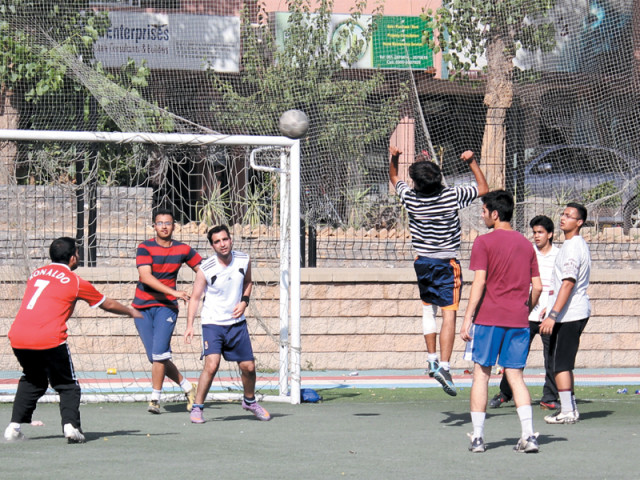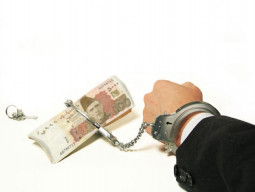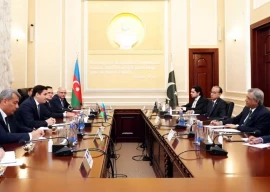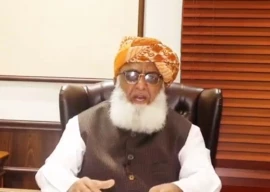
A few minutes later, he leaves his defensive position and moves forward into the opposing box. As the ball flies over the small crowd of players huddled in front of the goal, he ducks slightly to time his jump, then rises in the air from the left and heads the ball towards the goal. From six yards in, the keeper barely has time to react as the ball zooms past him and hits home. A brief celebration follows, and Zaheer runs back, shouting orders to his players to reorganise quickly.
Zaheer is the captain of Red Devils FC — a team he formed with his cousins and friends in 2007. He takes on the mantle of captain after his hours from work as senior executive at Fauji Fertilizer Bin Qasim Limited.
Zaheer and his teammates are prime examples of a subculture of amateur football players that has developed in some of the larger cities of Pakistan in recent years. From Karachi to Faisalabad and Rawalpindi, these hobbyist footballers are either students at private educational institutions or young professionals belonging to the upper middle class, and they religiously take time out to play club football.
“Back when we started in 2007, there would be one tournament every three or four months,” Zaheer says. “Nowadays there are so many tournaments that we have to choose which ones to play and which ones to leave.”
It’s no idle boast. Zaheer’s Red Devils played 16 tournaments in Rawalpindi and Islamabad in 2011 — all privately organised — of which they won seven. The prize money of a big tournament, typically between Rs18,000 and Rs25,000, is an added incentive for amateur teams that usually pay Rs2,000 to 4,000 as entry fees.
Schools are becoming important breeding grounds for aspiring football players and have teams regularly competing at inter-school tournaments. Daniyal Naeem, a 17-year-old A-levels student in Karachi, was only in the 8th grade when he formed a football team named CF Blitz with his school fellows. Naeem recalls that they weren’t really good in the beginning, but like all amateur footballers in Pakistan, they had no recourse but to rigorously practise by themselves to improve their game.
And like Naeem, 19-year-old Ans Khan also developed an interest in football in school when he was in the 4th grade and his school team competed in an annual football tournament held at the Hamdard Public School in Karachi. After finishing school, he formed his own team called FC Strikers with neighbourhood kids in Karimabad, Federal B Area.
“Football has really picked up among youngsters in recent years because people have had more exposure to the sport on television than ever before,” says Khan.
Before 1999, Pakistan Television was the only source for Pakistanis to watch international football competitions. Then the satellite dish service arrived and became the avenue for local audiences to watch foreign television channels. But foreign channels truly became ubiquitous when cable was introduced in Pakistan. Television cable would show specialised sports channels that broadcast European domestic leagues, especially the English Premier League on weekends and the Spanish La Liga late at night.
But where talent and interest in football are surging, there are not enough opportunities to match up with them.
“Pindi has a lot of football players, but we don’t have proper facilities,” laments Umair Tariq, a 22-year-old Mass Communications student at the National University of Sciences & Technology and a member of their football team.
There are three grounds in the city that are used for football, but locals mostly travel to Islamabad to play seven-a-side matches at the small but popular F-6 football ground. Teams pay Rs1,500 for 90 minutes and Rs2,500 if they play under lights at the facility run by the Capital Development Authority.
Hussain Ali, a groundskeeper who managed the facility as a private contractor until the CDA took over a year ago, says the ground hosts around 20 matches per week and generates a monthly revenue of around Rs100,000.
The average ground in Karachi also costs around Rs1,000 per game and the price goes up for grounds with better facilities.
Luckily for the sport, corporations are now cashing in on the growing popularity of football. Brand names have attached themselves to local football teams and are also sponsoring events, such as the 2o12 Zong United Kickoff Tournament, in which 32 kids won a chance to go to the Manchester United soccer school in Abu Dhabi for a five-day training programme, and the Pepsi football tournament simultaneously launched in three cities in June.
While club football has gained traction among urban, upper class youth, and stirred the interest of corporate bigwigs, football continues to be a poor man’s sport to a large extent. The divide between amateur and professional football in Pakistan seems to be drawn along class lines. The rich are playing the game for leisure, and the poor are struggling to get a decent future through football.
For this reason, skeptics continue to doubt any major breakthrough in domestic or national level football.
Riaz Ahmed, an administrator at Karachi United Football Foundation, says amateur footballers would never focus on making football their career because they are deterred by factors such as parental pressure, economic uncertainty, politics and nepotism in the existing system, and thus only play for enjoyment. This will do nothing for Pakistan’s domestic or national football scene, he says.
Even Muhammad Zaman, president of the Mehran football club — a registered professional club that plays in the official Islamabad district football league, asserts that amateur players commit themselves only part time, and eventually go abroad to study or get more lucrative jobs. “Parents are okay if their kids play sports for fun, but if kids get more interested in football, they step in saying it will interfere with their studies,” he says.
And when it’s difficult to eke out a living playing football, with professional club-level players getting paid as little as Rs1,000 per match and department football paying Rs20,000 in monthly salary, it’s hard to convince the parents otherwise.
It is no wonder then that most full-time players in this country are people from lower-income backgrounds, who are looking to secure a stable income and job security through employment as department footballers, says Ali Ahsan, chief editor of FootballPakistan.com, a website that is easily the most comprehensive resource for football news in the country.
Departments, such as Wapda, Army, KRL and Karachi Port Trust, have sizable sports budgets and offer match fees for tournaments and permanent jobs to football players, who are picked up from professional football clubs. Departments dominate professional football in Pakistan; 11 of the 16 teams that participated in the 2011 Pakistan Premier League were department teams. But not every club player makes the cut, because so many are vying for stable income and the job security it offers. Those who fail to make it to the department level, like Sabir Hussain, are left to find other sources of income.
Hussain almost got commissioned in the Army on a football quota in the ‘90s, but the deal went kaput in the final stages. Hussain now runs a garments shop in Rawalpindi’s Saddar market. But he has clung on to his passion for football as he sells football jerseys now, which go for Rs700 to Rs1,200 apiece. In the five years since he started selling football jerseys, he says he has sold 400 to 500 shirts every year — testimony to the growing popularity of football in Pakistan.
To give the sport a real boost, civil society has launched initiatives aimed at promoting football talent at the grassroots level. The Karachi United Football Foundation, a nonprofit entity, runs six centres in Karachi that provide football training to under-14 players.
“The idea is that if kids from underdeveloped areas get a chance to focus on football as a profession and undergo training, they can improve their future,” says Riaz.
These training centres also provide education support, vocational training and health awareness, in case these children do not go on to become professional footballers.
The foundation’s attempts are certainly noble, but they miss out on the talent in the amateur football circuit. FootballPakistan.com’s Ahsan insists reforms at the professional level might change that situation.
“Football needs to move away from departments to city-based teams,” he says. “We need to have public-corporate partnerships and media involvement in the domestic game to bring money, transparency, and coverage to football.” Only then will people from well-off backgrounds start taking football seriously.
Published in The Express Tribune, Sunday Magazine, August 26th, 2012.


















COMMENTS
Comments are moderated and generally will be posted if they are on-topic and not abusive.
For more information, please see our Comments FAQ